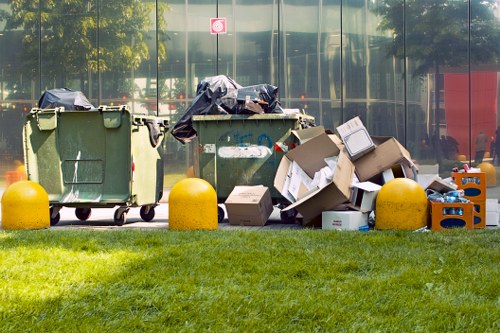Comprehensive Guide to Site Clearance in Turnham Green

Introduction to Site Clearance
Site clearance is a critical first step in any construction or renovation project. In Turnham Green, this process involves the removal of debris, vegetation, and existing structures to prepare the land for new developments. Proper site clearance ensures that the project proceeds smoothly, minimizing delays and unexpected costs.
Understanding the nuances of site clearance in Turnham Green is essential for property owners, contractors, and developers. This guide aims to provide a thorough overview of the processes, regulations, and best practices involved in site clearance within this specific area.
Whether you're embarking on a small residential project or a large commercial development, effective site clearance lays the foundation for success. Let’s explore the various aspects of this essential service.

Why Site Clearance is Important
Site clearance is more than just the removal of unwanted materials; it serves several vital functions that contribute to the overall success of a construction project.
Ensuring Safety
Clearing a site removes potential hazards such as debris, unstable structures, and toxic materials. This creates a safer environment for workers and reduces the risk of accidents during construction.
Optimizing Space Utilization
Proper site clearance ensures that the land is fully prepared for building, maximizing the use of available space. This includes grading the land to prevent water accumulation and ensuring a stable foundation for structures.
Compliance with Regulations
In Turnham Green, site clearance must adhere to local regulations and environmental guidelines. Proper clearance helps in obtaining necessary permits and avoiding legal complications that can delay the project.

Steps Involved in Site Clearance
The site clearance process involves several key steps, each essential for preparing the site for construction.
1. Site Assessment
Before any physical work begins, a thorough site assessment is conducted. This includes evaluating the current state of the land, identifying any existing structures, vegetation, and potential hazards.
2. Planning and Permitting
Developing a clear plan for site clearance is crucial. This includes securing the necessary permits from local authorities in Turnham Green and ensuring compliance with environmental and safety regulations.
3. Removal of Vegetation
Clearing unwanted vegetation, including trees, shrubs, and grass, is often necessary. This step may involve the use of machinery or manual labor, depending on the density and type of vegetation.
4. Demolition of Existing Structures
If there are existing buildings or structures on the site, they need to be safely demolished and removed. This process must be handled by professionals to prevent damage to surrounding areas and ensure proper disposal of materials.
5. Debris Removal
All debris, including construction waste and hazardous materials, must be removed and disposed of in accordance with local regulations. Proper disposal is crucial to maintaining environmental standards and site safety.
6. Land Grading and Leveling
After clearing the site, the land is graded and leveled to create a stable foundation for future construction. This step involves adjusting the slope and elevation of the land to ensure proper drainage and stability.

Regulations and Compliance in Turnham Green
Adhering to local regulations is a fundamental aspect of site clearance in Turnham Green. Failure to comply can result in fines, project delays, and legal challenges.
Environmental Considerations
Turnham Green places a strong emphasis on protecting the environment. During site clearance, it is essential to conduct environmental impact assessments to minimize disruption to local ecosystems.
Waste Management
Proper waste management practices must be followed, ensuring that all materials are disposed of responsibly. Recycling and repurposing materials when possible can also help reduce the environmental footprint of the project.
Health and Safety Standards
Maintaining high health and safety standards during site clearance is mandatory. This includes providing appropriate safety gear for workers, securing the site to prevent unauthorized access, and implementing measures to mitigate potential hazards.
Permitting Process
Obtaining the necessary permits is a critical step. This involves submitting detailed plans and adhering to guidelines set by local authorities in Turnham Green. Working with experienced site clearance professionals can streamline this process.

Choosing the Right Site Clearance Company
Selecting a reputable site clearance company in Turnham Green is crucial for the success of your project. Here are key factors to consider:
- Experience and Expertise: Look for companies with a proven track record in site clearance, particularly in the Turnham Green area.
- **Licensing and Insurance:
- Ensure the company is properly licensed and insured to handle site clearance tasks.
- **Equipment and Technology:
- Modern equipment and advanced technology can enhance efficiency and safety during site clearance.
- **Compliance and Environmental Practices:
- Choose companies that prioritize compliance with local regulations and implement environmentally friendly practices.
- **Customer Reviews and Testimonials:
- Research customer feedback to gauge the reliability and quality of the company's services.
Benefits of Hiring Professionals
Engaging professional site clearance services offers numerous advantages, including:
- Efficiency: Professionals can complete site clearance tasks quickly and effectively, saving time and resources.
- **Safety:
- Experienced teams are trained to handle hazardous materials and prevent accidents.
- **Quality Assurance:
- Professional companies ensure thorough clearance, reducing the likelihood of issues during subsequent construction phases.
- **Cost-Effectiveness:
- While there is an upfront cost, professional clearance can prevent costly mistakes and delays in the long run.
Questions to Ask Potential Contractors
Before hiring a site clearance company, consider asking the following questions:
- What is your experience with site clearance projects in Turnham Green?
- Are you licensed and insured?
- Can you provide references or case studies of past projects?
- What equipment do you use for site clearance?
- How do you handle waste disposal and recycling?
- What is your process for ensuring compliance with local regulations?

Cost Factors in Site Clearance
The cost of site clearance in Turnham Green can vary based on several factors. Understanding these can help you budget effectively for your project.
Size of the Site
Generally, larger sites require more time and resources to clear, increasing the overall cost. The amount of vegetation, debris, and existing structures will also impact pricing.
Type of Materials
The nature of the materials to be cleared plays a significant role. Handling hazardous waste or large structures typically costs more due to the specialized equipment and expertise required.
Accessibility
Sites that are difficult to access may incur additional costs. Limited access can slow down the clearance process and necessitate the use of specialized machinery.
Regulatory Compliance
Adhering to environmental and safety regulations may require additional steps, such as obtaining permits and conducting environmental impact assessments, which can add to the cost.
Timeline
Urgent projects that require expedited site clearance may come with higher fees. Planning your project timeline carefully can help manage costs effectively.
Additional Services
Some site clearance companies offer additional services such as land grading, soil testing, and demolition. Bundling these services can sometimes reduce overall costs.
Cost-Saving Tips
- **Plan Ahead:
- Early planning can help avoid last-minute expenses and allow for better budgeting.
- **Get Multiple Quotes:
- Comparing quotes from different companies can help you find the best deal without compromising quality.
- **Optimize Site Layout:
- Efficient site layout can reduce the amount of clearance needed, thereby lowering costs.
- **Reuse and Recycle:
- Reusing materials where possible can decrease waste disposal fees.

Environmental Impact of Site Clearance
Site clearance can have significant environmental implications. It’s crucial to approach this process responsibly to minimize negative impacts.
Sustainable Practices
Implementing sustainable practices during site clearance can greatly reduce environmental harm. This includes recycling materials, minimizing waste, and preserving existing vegetation where possible.
Impact on Local Ecosystems
Clearing a site can disrupt local ecosystems, affecting plant and animal life. Conducting environmental assessments helps identify and mitigate these impacts, ensuring that sensitive areas are protected.
Soil Preservation
Maintaining soil integrity is vital for future construction and environmental health. Proper grading and leveling techniques prevent erosion and promote soil stability.
Carbon Footprint
Reducing the carbon footprint of site clearance activities involves using energy-efficient equipment, minimizing transportation distances, and adopting eco-friendly disposal methods.
Regulatory Compliance
Adhering to environmental regulations not only ensures compliance but also promotes sustainable development. Engaging with local environmental agencies can provide guidance on best practices.
Innovative Solutions
- **Green Demolition Techniques:
- Using methods that reduce dust and noise pollution improves the environmental footprint of site clearance activities.
- **Biodegradable Materials:
- Incorporating biodegradable materials where possible can lessen the long-term environmental impact.
- **Energy-Efficient Machinery:
- Investing in energy-efficient machinery reduces fuel consumption and emissions.
- **Reforestation Programs:
- Participating in reforestation efforts helps replenish natural vegetation and supports biodiversity.

Common Challenges in Site Clearance
Site clearance in Turnham Green, while essential, can present several challenges. Being aware of these can help in planning and mitigating potential issues.
Unexpected Obstructions
Discovering unforeseen obstacles, such as hidden utilities or archaeological artifacts, can delay the clearance process. Conducting thorough site assessments beforehand can help anticipate these challenges.
Weather Conditions
Adverse weather can impede site clearance activities, causing delays and increasing costs. Planning for weather contingencies ensures that the project stays on track.
Regulatory Hurdles
Navigating complex regulations and obtaining necessary permits can be time-consuming. Collaborating with experienced professionals can streamline this aspect.
Environmental Concerns
Balancing site clearance with environmental preservation requires careful planning. Implementing eco-friendly practices minimizes the negative impact on the surrounding area.
Cost Management
Keeping site clearance within budget can be challenging, especially when unexpected issues arise. Detailed budgeting and contingency planning are essential for effective cost management.
Strategies to Overcome Challenges
- **Comprehensive Planning:
- Developing a detailed site clearance plan helps identify potential obstacles early.
- **Engage Professionals:
- Hiring experienced site clearance experts can provide valuable insights and solutions to complex issues.
- **Flexible Scheduling:
- Allowing flexibility in the project timeline can accommodate unforeseen delays.
- **Continuous Monitoring:
- Regularly monitoring the site ensures that any emerging challenges are addressed promptly.

Technological Advances in Site Clearance
Advancements in technology have significantly enhanced the efficiency and effectiveness of site clearance operations in Turnham Green.
Modern Machinery
State-of-the-art machinery, such as excavators, bulldozers, and skid steer loaders, increase the speed and precision of site clearance tasks. These machines are equipped with advanced features that improve performance and safety.
Software Solutions
Project management software and geographic information systems (GIS) help in planning, tracking, and managing site clearance activities. These tools provide real-time data and analytics, facilitating informed decision-making.
Drones and Aerial Surveillance
Drones offer an aerial perspective of the site, allowing for better assessment and monitoring. They can identify problem areas, track progress, and ensure that clearance is proceeding as planned.
Eco-Friendly Technologies
Green technologies, such as electric-powered machinery and renewable energy sources, are reducing the environmental impact of site clearance operations.
Automation and Robotics
Automation and robotics are streamlining various aspects of site clearance, from debris removal to demolition, enhancing efficiency and reducing the need for manual labor.
Benefits of Technological Integration
- **Increased Efficiency:
- Technology accelerates site clearance processes, saving time and resources.
- **Enhanced Safety:
- Advanced machinery reduces the risk of human error and accidents on site.
- **Improved Accuracy:
- Precision tools ensure thorough and accurate clearance, minimizing residual debris.
- **Cost Savings:
- Efficient operations lead to lower labor costs and reduced material wastage.
Future Trends
The future of site clearance in Turnham Green looks promising with ongoing technological innovations. Integration of artificial intelligence (AI) and machine learning can further optimize clearance strategies, while sustainable technologies will continue to play a crucial role in reducing environmental impacts.

Case Studies of Successful Site Clearance in Turnham Green
Examining successful site clearance projects provides valuable insights and lessons for future endeavors in Turnham Green.
Residential Development Project
A residential project in Turnham Green required extensive site clearance, including the removal of old structures and dense vegetation. By employing advanced machinery and sustainable practices, the project was completed ahead of schedule and within budget, setting a benchmark for future residential developments.
Commercial Complex Clearance
Clearing a site for a new commercial complex involved handling hazardous materials and ensuring minimal disruption to the local community. The project team implemented strict safety protocols and engaged with environmental experts to ensure compliance, resulting in a successful and environmentally responsible clearance.
Green Space Redevelopment
A project aimed at redeveloping a green space in Turnham Green focused on preserving existing trees and enhancing biodiversity. The site clearance process was meticulously planned to balance development needs with environmental conservation, earning praise from local authorities and residents alike.
Industrial Site Transformation
Transforming an old industrial site into a modern mixed-use development required comprehensive site clearance, including soil remediation and demolition of outdated structures. The project utilized innovative techniques and technologies to ensure a thorough and efficient clearance, paving the way for a successful redevelopment.
Key Takeaways from Case Studies
- Planning and Preparation: Detailed planning is essential for addressing specific site challenges.
- **Sustainable Practices:
- Incorporating eco-friendly methods enhances project sustainability and community acceptance.
- **Professional Expertise:
- Engaging skilled professionals ensures high-quality site clearance and compliance with regulations.
- **Community Engagement:
- Communicating with local stakeholders fosters positive relationships and smooth project execution.
Lessons Learned
Successful site clearance projects in Turnham Green highlight the importance of meticulous planning, adherence to regulations, and the integration of sustainable practices. These lessons serve as a guide for future projects, emphasizing the balance between development and environmental stewardship.
Conclusion
Site clearance in Turnham Green is a complex yet essential process that sets the stage for successful construction and development projects. By understanding the importance, following the necessary steps, adhering to regulations, and leveraging modern technologies, property owners and developers can ensure efficient and effective site clearance.
Choosing the right professionals and implementing sustainable practices not only enhances the quality of the clearance but also contributes to the overall well-being of the community and environment. As Turnham Green continues to grow and develop, the role of meticulous site clearance becomes increasingly pivotal.
Ready to start your project? Contact us today to ensure your site clearance in Turnham Green is handled with expertise and care.
Frequently Asked Questions
1. What does site clearance entail?
Site clearance involves the removal of vegetation, debris, existing structures, and any other materials to prepare the land for construction or development.
2. How long does site clearance take?
The duration of site clearance depends on the size of the site, the extent of the materials to be removed, and any specific challenges such as hazardous materials or difficult terrain.
3. Are there environmental regulations for site clearance in Turnham Green?
Yes, site clearance in Turnham Green must comply with local environmental regulations, including waste management, protection of local ecosystems, and adherence to safety standards.
4. Can site clearance be done in stages?
Yes, depending on the project requirements, site clearance can be performed in stages to manage resources effectively and minimize disruptions.
5. How are hazardous materials handled during site clearance?
Hazardous materials must be identified, safely removed, and disposed of in accordance with local regulations to prevent environmental contamination and ensure safety.
6. What are the costs associated with site clearance?
Costs vary based on factors such as site size, type of materials, accessibility, regulatory compliance, and the extent of additional services required.
7. How can I ensure my site clearance project stays on budget?
Thorough planning, obtaining multiple quotes, engaging experienced professionals, and considering cost-saving measures can help keep your site clearance project within budget.
8. What equipment is used in site clearance?
Common equipment includes excavators, bulldozers, skid steer loaders, and specialized machinery for demolition and debris removal.
9. Is it necessary to hire a professional for site clearance?
While DIY site clearance is possible for small projects, hiring professionals ensures efficiency, safety, and compliance with regulations, especially for larger or more complex sites.
10. How do I choose the right site clearance company in Turnham Green?
Consider factors such as experience, licensing, customer reviews, equipment, and commitment to sustainable practices when selecting a site clearance company.